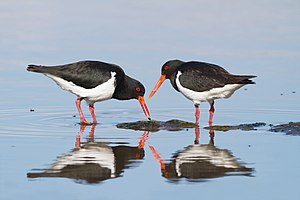Pied oystercatcher
| Pied oystercatcher | |
|---|---|

| |
| Scientific classification | |
| Kingdom: | |
| Phylum: | |
| Class: | |
| Order: | |
| Family: | |
| Genus: | |
| Species: | H. longirostris
|
| Binomial name | |
| Haematopus longirostris Vieillot, 1817
| |
The pied oystercatcher (Haematopus longirostris) is a species of oystercatcher. It is a wading bird native to Australia and commonly found on its coastline. The similar South Island pied oystercatcher (H. finschi) occurs in New Zealand.
Description

The name "oystercatcher" is something of a misnomer for this species, because they seldom eat oysters, which are found mainly on rocky coastlines.[2] Pied oystercatchers frequent sandy coastlines, where they feed mainly on bivalve molluscs, which are prised apart with their specially adapted bill.
This Australian species is easily recognized by the characteristic 5–8 cm long orange-red beak, slender pink legs and black and white plumage.[3] With the wings extended, a white wing-stripe is also visible. The male and female show little differentiation, except that the males generally sport a shorter, wider beak.[4]
Habits

Pied oystercatchers feed mainly on bivalve molluscs, but also take other invertebrates. The techniques they use to break open the shells of the molluscs vary greatly and are thought to be learned behavior.[4]
They nest in shallow scrapes made in open areas near the shore and produce 2–3 eggs in a typical clutch. Each couple protects its nesting area and often uses the same area year after year. Like the gulls they share the shore with, oystercatchers will band together to mob a perceived threat.[4]
Conservation status
The pied oystercatcher is considered federally to be 'secure' and in New South Wales, Australia, is listed as 'endangered'.[3]
References
- ^ Template:IUCN
- ^ "Pied Oystercatcher" (PDF). National Parks and Wildlife Services. Retrieved 2 February 2012.
- ^ a b "Endangered" (PDF). Retrieved 8 February 2013.
- ^ a b c "Pied OysterCatcher" (PDF). Retrieved 8 February 2013.

